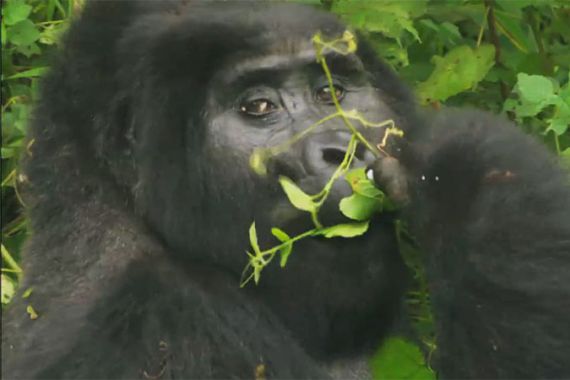
Return of the Apes
Thanks to a unique conservation effort, one of the rarest mammals on earth is making a comeback.
Gorillas, once a species at the brink of extinction, are making a remarkable comeback in Uganda’s Bwindi Impenetrable Forest. Between 2003 and 2006, their numbers rose by over 25 per cent and there are now more than 480 animals living in the Virunga Massif area. This success is partly due to the work of the International Gorilla Conservation Programme (IGCP). The organisation has played a key role in reducing poaching, disease and other human-wildlife conflict. Nick Clark describes witnessing the results of their work up close.
Getting up close and personal with a mountain gorilla is a pretty humbling experience. You get so near that you are actually in range of their body odour – a pungent, sickly-sweet smell of old sweat. It is not far from the aroma we would radiate, if we had been roaming the forest all our lives sans shower gel. We have 98 per cent of the same DNA as the mountain gorilla.
Keep reading
list of 4 itemsAfter the Hurricane
World’s coral reefs face global bleaching crisis
Why is Germany maintaining economic ties with China?
Safari, the big, muscular Alpha Male, stares you down a bit then purposefully walks by, so close you could reach out and touch him. You don’t, of course, because you are rooted to the spot, by an adrenalising combination of fear and wonder.
A couple of infants, no more than two years old, crash about in the trees. Their mother, sitting on her haunches, chews great handfuls of fibrous leaves.
The group has been habituated to human presence and you could, therefore, argue that they are not truly wild. But this experience brings in millions of tourist dollars every year, benefitting both man and beast.
For the mountain gorilla is one of the rarest mammals on earth. By 1989, poaching and habitat destruction had seen the numbers crash to fewer than 600. Extinction was close at hand.
But the mountain gorilla is making something of a comeback – it is believed that there are now more than 800. And it is all down to a unique conservation effort.
Gorillas in the mist
Flying at low altitude in mist swirling over the jungle-clad mountain tops, in a small, heavily loaded Cessna, is no mean feat. Our pilot is a diminutive Japanese woman called Sanae Ishitani. She brings us down to Kisgari airfield in the Ugandan highlands.
“At this level of elevation you lose 80 per cent of engine performance,” she explains. “Then you have cloud covering the top of the mountains obscuring your route in. It’s tricky.”
“Difficult … but beautiful,” I say, looking down on the ethereal landscape.
We are deep in central Africa, flying into one of the most ancient habitats on the continent, which clings to the western edge of the Great Rift Valley.
Here is where the borders of Congo, Rwanda and Uganda meet. And here is the last refuge of the mountain gorilla.
Crop raiders
From above you can see how the hillsides have been stripped bare for cultivation. The gorillas’ range is now tightly squeezed into the boundaries of Bwindi National Park and the Virunga Mountains.
From the ground you can see the hard, steep edge of the National Park, where virgin forest butts up against cultivated land.
“Because of population pressures, the communities cultivate right up to the park edge and this introduces an element of conflict between man and gorilla,” explains Stephen Asuma of the International Gorilla Conservation Programme.
“The gorillas will naturally come for the easy pickings and raid villagers’ crops.”
In the past, the villagers would sometimes seek retribution, killing the culprits. So now a 12km buffer zone has been established along the fringes of Bwindi National Park.
“It incorporates open land which the gorillas don’t like to cross,” says Asuma. “This section is then lined all the way along by a thorn hedge, to discourage the more determined raiders.”
Community benefits
So the local community is learning to share an overlap of land with the gorillas. But the comeback of these endangered animals is down to more than just compromise.
Some locals have gotten jobs within the conservation programme itself, becoming guides or trackers. Others make money from basket weaving and carvings.
We spoke to Constance Tumusiime who runs a community co-operative. “We are benefitting from the gorillas now,” she tells us.
“Because the guests and the tourists come and buy our things. We like the gorillas. We and the gorillas, we are friends.”
Looking after these iconic animals goes further still. The Mountain Gorilla Veterinary Programme monitors the health of the animals across Congo, Rwanda and Uganda.
Gorilla doctors
Deep in the forest, three metres from a large Silverback called Kirungi, I sit and talk in hushed tones with gorilla doctor Fred Nizeyimana.
“Kirungi had been in a fight and had injured his left jaw, so I’ve come to see how he’s doing,” Nizeyimana says. “I’m pleased to see it’s healed, the swelling has reduced.”
The gorilla doctors only ever intervene and administer medical treatment if it looks as if the animal will otherwise die. And it has worked.
“It’s been shown that veterinary medical care interventions have contributed to the upturn in the gorilla population,” Nizeyimana explains. “There’s still a long way to go but we’re hopeful we can reach a point where we are conserving for generations. Our goal is to put the gorilla doctors out of business!”
It was not long ago that we might have been talking about the end of the very existence of the mountain gorilla on this planet.
But now there is this incredible fact: the mountain gorilla is the only one of the five great apes, whose numbers are actually increasing.